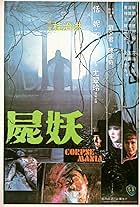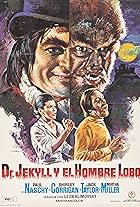The spirit of a long-dead warrior possesses the body of an Indian medicine man and turns him into a homicidal maniac.The spirit of a long-dead warrior possesses the body of an Indian medicine man and turns him into a homicidal maniac.The spirit of a long-dead warrior possesses the body of an Indian medicine man and turns him into a homicidal maniac.
Frank Salsedo
- Ocacio
- (as Frank Sotonoma Salsedo)
Henry Kendrick
- Lt. Deleo
- (as Henry Max Kendrick)
Frank Soto
- Basowaya
- (as Frank A. Soto)
Kirk Koskella
- Phalan
- (as Kirk Irving Koskella)
Don Shanks
- Excavation Worker
- (as Donald L. Shanks)
Storyline
Did you know
- TriviaFilmed in and around Tucson, Arizona in eight weeks during the summer of 1980 on a $1 million budget.
Featured review
Dances with ghosts
Dr. Kay Foster is the head anthropology professor at an Arizona museum and university. Overseeing the excavation of Indian artifacts in the desert, she and her crew unearth the remains of a sadistic Indian shaman named Nahalla. Later that night, after the mummified carcass is carted off to Kay's museum, an Indian bum sneaks into the dig site and steals a pouch which belonged to the shaman. Believing that he will harness great powers and resurrect Nahalla himself to walk beside him, the thief uses the pouch's contents in the performance of a blood ritual. Nahalla is resurrected, but rather than walk beside a lowly thief, he instead takes over his body. During a time when American settlers had taken over most of their land and the Indians had lost hope, the advent of the ghost dance cult renewed their spirit. The cult was founded on the idea of a world soon to be inhabited solely by Indians, including their long-dead ancestors, and where the buffalo would once again roam in force. Rather than believe in such a thing, Nahalla took up his own cause against the white man, namely that of torture and death. Now in the present and as bloodthirsty as ever, the legendary madman sets his sights on the museum staff.
"The Ghost Dance" is a relatively obscure slasher film from the sub-genre's early days. It's obscurity is certainly undeserved, as it's one of the best slashers I've come across. Horror films which center on Native American themes are often among my favorites to watch. I've always been fascinated by the various Indian tribes and their ways of life. Learning about their cultures, legends and beliefs was one of my favorite parts of history class. What's more, the mythology and superstitions of their people are fertile grounds for horror tales. Hell, many of the old Indian legends are basically horror stories in and of themselves. Not only that, but they're actually frightening. Combining such elements with a slasher was a novel idea.
Peter F. Buffa's film is well-made, one or two jarring scene transitions not withstanding. The VHS transfer is beat up, but you can tell that it's an exceptionally filmed picture. The secluded desert vistas definitely help, as does the atmospheric museum which is effectively imposing at night. Indeed, two of the film's best sequences take place in the dimly-lit confines of the museum. One involves the double-murder of two people who's liaison in an old stagecoach is rudely interrupted. The other has Nahalla chasing Kay through the museum corridors, eventually making their way to the bird display. This leads to the striking image of Nahalla standing in front of a stuffed eagle, his back looking like it has sprouted wings. Not only the most memorable shot of the film, but a thematically rich one as well. That said, it's actually the second standout visual we're treated to here. When the thief is on his way to the site of his blood ritual earlier in the film, we get a terrific shot of him amidst the mountains and a stormy, lightning-filled sky. Again, the VHS is a bit of a mess, and this thing is in desperate need of a loving restoration.
As Kay, Julie Amato makes for a strong heroine. She carries herself with a sense of authority, never coming across as helpless despite the trouble she finds herself in later. The twist involving her character about midway through is predictable, but that doesn't take away from the film. Henry Bal is Nahalla, and he's most assuredly a formidable slasher villain. One of my favorite sequences has Kay driving to a dinner date, Nahalla eerily popping up along the road every step of the way. Another has the revived shaman stalking her in the form of a house cat. Kay is a very appealing final girl, and there was tension in wondering what would happen to her. That's more than I can say for most final girls. The film's score has it's moments, enhancing the mood at it's best, sounding generic or even somewhat cartoonish (during the museum chase) at it's worst. The kills aren't overly graphic, but they're nothing to sneeze at either, particularly those of the stagecoach twosome. The ending is a little sudden, but it works.
It's a pity that Buffa never directed another film. He clearly knew what he was doing, as "The Ghost Dance" doesn't come off as the work of an amateur. There are flaws, sure, but nothing major. This is a quality slasher that cuts deeper than the norm. You wouldn't want to dig up Nahalla, but this film is another story. It's like striking gold for slasher fans.
"The Ghost Dance" is a relatively obscure slasher film from the sub-genre's early days. It's obscurity is certainly undeserved, as it's one of the best slashers I've come across. Horror films which center on Native American themes are often among my favorites to watch. I've always been fascinated by the various Indian tribes and their ways of life. Learning about their cultures, legends and beliefs was one of my favorite parts of history class. What's more, the mythology and superstitions of their people are fertile grounds for horror tales. Hell, many of the old Indian legends are basically horror stories in and of themselves. Not only that, but they're actually frightening. Combining such elements with a slasher was a novel idea.
Peter F. Buffa's film is well-made, one or two jarring scene transitions not withstanding. The VHS transfer is beat up, but you can tell that it's an exceptionally filmed picture. The secluded desert vistas definitely help, as does the atmospheric museum which is effectively imposing at night. Indeed, two of the film's best sequences take place in the dimly-lit confines of the museum. One involves the double-murder of two people who's liaison in an old stagecoach is rudely interrupted. The other has Nahalla chasing Kay through the museum corridors, eventually making their way to the bird display. This leads to the striking image of Nahalla standing in front of a stuffed eagle, his back looking like it has sprouted wings. Not only the most memorable shot of the film, but a thematically rich one as well. That said, it's actually the second standout visual we're treated to here. When the thief is on his way to the site of his blood ritual earlier in the film, we get a terrific shot of him amidst the mountains and a stormy, lightning-filled sky. Again, the VHS is a bit of a mess, and this thing is in desperate need of a loving restoration.
As Kay, Julie Amato makes for a strong heroine. She carries herself with a sense of authority, never coming across as helpless despite the trouble she finds herself in later. The twist involving her character about midway through is predictable, but that doesn't take away from the film. Henry Bal is Nahalla, and he's most assuredly a formidable slasher villain. One of my favorite sequences has Kay driving to a dinner date, Nahalla eerily popping up along the road every step of the way. Another has the revived shaman stalking her in the form of a house cat. Kay is a very appealing final girl, and there was tension in wondering what would happen to her. That's more than I can say for most final girls. The film's score has it's moments, enhancing the mood at it's best, sounding generic or even somewhat cartoonish (during the museum chase) at it's worst. The kills aren't overly graphic, but they're nothing to sneeze at either, particularly those of the stagecoach twosome. The ending is a little sudden, but it works.
It's a pity that Buffa never directed another film. He clearly knew what he was doing, as "The Ghost Dance" doesn't come off as the work of an amateur. There are flaws, sure, but nothing major. This is a quality slasher that cuts deeper than the norm. You wouldn't want to dig up Nahalla, but this film is another story. It's like striking gold for slasher fans.
Details
Box office
- Budget
- $1,000,000 (estimated)
Contribute to this page
Suggest an edit or add missing content






















